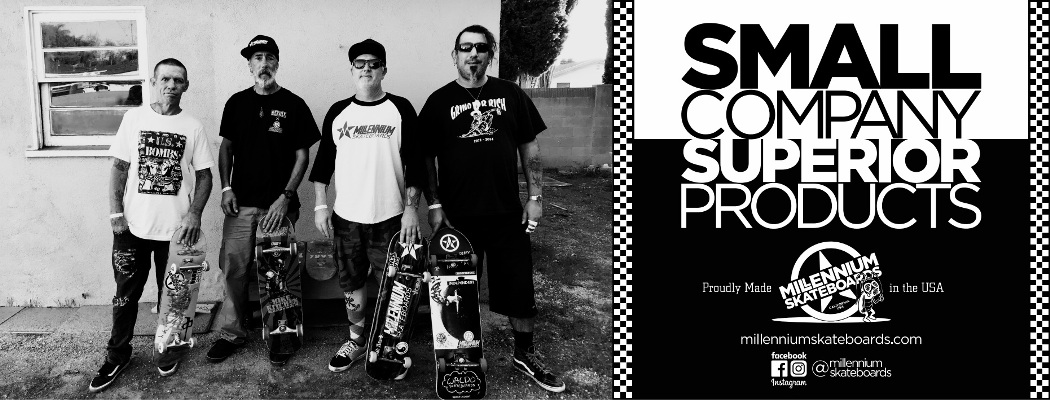

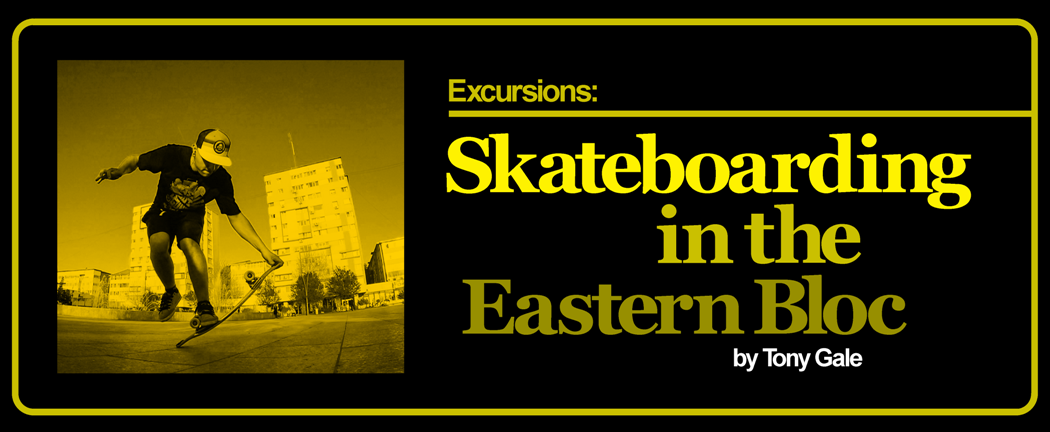
Skateboarders over a certain age often seem surprised to see me freestyle. There’s a common belief, consciously propagated by the “industry” and the associated media, that freestyle is totally dead – a belief not helped, admittedly, by the tendency of freestylers to hide in abandoned parking lots and empty basketball courts. Generally, I tend to inform these folks that yes, freestyle is alive and well, with strong regional scenes in various parts of the world, most notably Brazil, Japan, Sweden, the UK, Germany and, oddly, Romania.
The presence of skateboarding – never mind freestyle – in this former Soviet satellite state is a relatively new development. Behind the Iron Curtain, skateboards were a rare sight; any available skateboards were all locally-produced, with designs almost a decade behind the western skate industry (this article from East Germany shows what Communists were dealing with in 1987, for god’s sake). There were a few trips across the Curtain by European skaters, most notably for a competition in Prague in 1988 which was covered by Thrasher, but skateboarding didn’t really get an opportunity to thrive until the dissolution of the Soviet Union. As such, the community and culture – in Romania at least – is still very young. There’s not a lot of home-brew skateboard companies or manufacturing, and both skateshops and skateparks are few and far between.
This is where Marius Constantin comes in. Marius is 31 years old now, and I first met him at the Paderborn BBQ contest in Germany back in 2015. I’d known about him for a few years prior to that, though; Marius is one of the most pro-active and enthusiastic supporters of freestyle in Europe – if not the world – and made a name for himself in Romania as being one of the most visible Romanian skateboarders on YouTube, first by documenting his local scene in a series of videos, and later, doing trick tips in his native language.
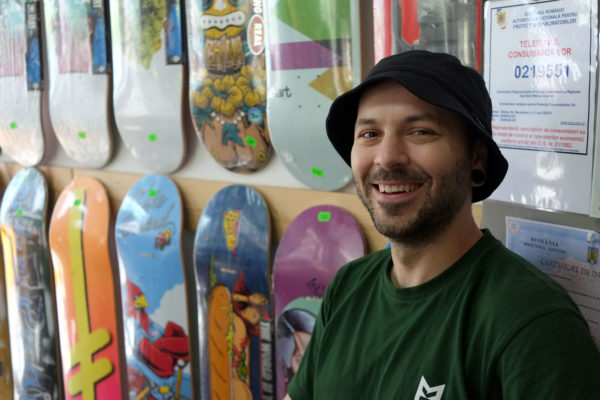
Generally speaking, the idea of the skateboarding “YouTuber” brings bile to the back of my throat, and from what I see, many other skateboarders have similar responses. There’s a lot of nonsense, ego, and self-promotion in that sphere, but Marius came to the platform with a different approach: he wanted to promote everyone else, not himself. Marius isn’t the star, he’s the scene-builder – something which was evident every single time I saw him on the “contest circuit”. He never wanted to talk to me about the latest tricks he landed, only the tricks his many young freestyle proteges had learned. He always seemed more stoked about showing me a video of a young Romanian child from an impoverished village doing a pogo on a cheap, battered board than his latest rail combo, and that was refreshing. I quickly realised Marius was quietly building up this little freestyle scene; pretty soon, he started bringing some of the teenagers he was teaching and supporting to events – and they were good. Really good.

In all honesty, I’d been thinking of going to Romania for a long time to see what was happening over there. Marius kept inviting me, and I kept making excuses to myself; it’s hard balancing a day job, family life and travelling, and I just didn’t have it in me to jump on a plane. However, when I realised I’d made up my mind to not go to the World Round Up in Vancouver again, I realised this gave me the time and funds I needed, and the decision was made. I spoke to Marius, checked he was free, and booked a flight.

There’s an old joke, dating back to the Cold War: during the Space Race, NASA realised a regular ballpoint pen wouldn’t work without gravity, and spent millions of dollars developing a replacement that would work in orbit. The Soviet Union, on the other hand, simply used a pencil.
While this turned out to be false, there’s some truth in it: the people of the Soviet Union had a habit of finding simple solutions to problems, some of which were elegant, some of which… not so much. As soon as I arrived in Bucharest, I realised this obviously still existed in Romania. Rather than taxi the plane up to the terminal and have an expensive tunnel to connect to the door, the biggest international airport in Romania just leaves the plane on the tarmac and brings buses out for the passengers. As I’m riding back to the terminal, I then see a distinctly Soviet-looking tractor – a proper agricultural piece of farming equipment – being used to tow the baggage back to the airport. I’d see various examples of this “keep it simple, stupid” mentality during my trip, and while it was sometimes amusing to see, it was a refreshing change to the overly bureaucratic nonsense I see back home.

In conversations I had with Marius over the years, one thing came up time and again: freestylers in Romania just couldn’t get product. In England, we always had to import our gear from the US, so I understood his plight. He’d got kids cutting down street boards, but they couldn’t get freestyle wheels or skidplates; he was trying to get local shops to bring in suitable product, but as is often the case, shops are too conservative to support what they perceive as a small niche, and would rather sell shoes and clothing. So Marius did what Marius does, and did it himself. He started a shop, and started importing and stocking the product himself. Based in his home town of Slatina, about two hours away from Bucharest, Nose and Tail supplies freestylers across Romania, but due to the amount of respect Marius has earned from the skate scene in general, often gets customers from larger towns who’d rather support a real skater instead of the businessmen who run their local shops, who they see as only interested in profit.
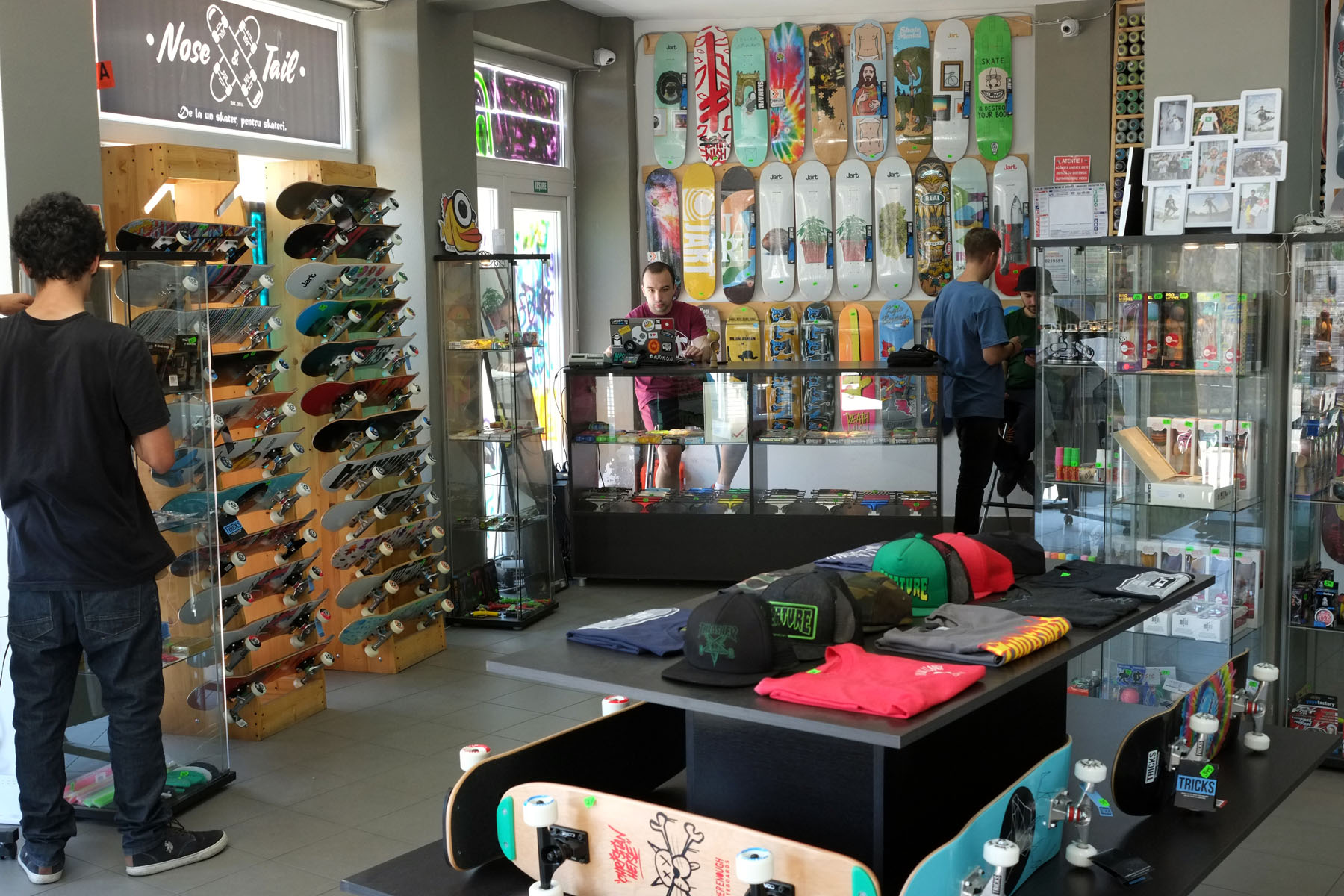
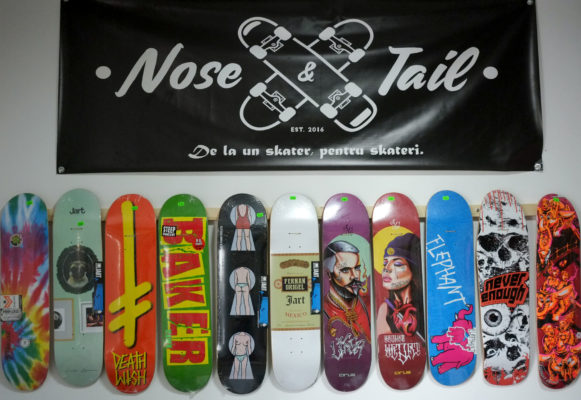
The banner roughly translates as “from the skaters, for the skaters”.

On my first day in Romania, we went on a small tour of Slatina’s old district (in summary: absolutely beautiful but almost completely abandoned), and then swung by the skate shop to check in on Alexandru Lilea, a young freestyler to whom Marius gave a full-time job. In a country where the monthly minimum wage is around 1800 Lei (about $450 USD or €385 EUR) but a pro deck still costs about 265 Lei ($66 / €57) – and a freestyle complete can run to an eye-watering 800 Lei, meaning you’d have to work for over two weeks to afford one – Marius is keen on supporting his proteges where he can, often buying them food during sessions and giving them product when they need it. Like most days in most skateshops, it was pretty quiet when we turned up (a lot of Nose and Tail’s trade is online), so we found Lilea doing literally nothing to earn his keep. I’m pretty sure he was just idling away the hours on Youtube, to be honest. But someone has to keep the doors open, and if it means he can afford dinner at the end of the day, Lilea’ll do it.

I took the opportunity to look around Nose and Tail, and found it surprisingly well-stocked, considering the cost of everything; there was a good mix of board brands and shapes, with both European independents and American big names represented on the walls. Marius also carries the best budget brands he can find to try to make sure the poorer kids can have a decent ride, too. One big surprise was that unlike British shops, which tend to carry themselves along from month to month by selling shoes, Nose and Tail stocks a lot of seemingly unrelated product like spray paint and kendamas, but barely any footwear at all. Apparently there was a big kendama trend last year, which ended up bringing in a huge amount of money to the shop. (Who would have thought ball-in-a-cup could prove so lucrative?)
The one thing Nose and Tail has in common with its English counterparts is Thrasher tees, however. Marius had to arrange for them to be imported specially, as no one else was carrying them in Romania, and it apparently ended up being a smart move. Got to stay ahead of the trends to stay alive.
Finally, as the afternoon cooled down (it gets unreasonably hot in Romania during the summer), we went for our first skate session of the trip; Marius loaded up his car with myself, the two Alexandrus (Lilea and Stirbu), and we headed out to nearby Craiova, picking up Daniel Popescu, a 12-year old beginner from the countryside who was stoked to be joining us. Craiova is a beautiful, vibrant place, where they’ve pumped money into the old town and turned it into a fantastic space, full of life. When we turned up at the spot – a beautiful plaza in the centre of the city – it was already bustling with all sorts of activity. There were kids playing football (that’s “soccer” to any Americans reading this), riding around on bikes, playing guitar, and, of course, skateboarding. The guys who were already skating there were street skaters, doing tricks up and down the small drops from one section to the next, and many of them had spent time in other European countries for work. They were pretty surprised to see an Englishman in Romania – I guess not many folks from West Europe make the trip. All in all it was a pretty cool trip, but it was interesting seeing how so many of the Craiova crew fitted the exact same street skating stereotypes I see in other countries; the same clothing, the same attitudes, the same aloofness. One of Marius’ friends back in Slatina expressed his distaste at that, saying they “weren’t real Romanian skaters”. I guess the industry’s marketing schemes are even starting to take root in Eastern Europe now.
Like an idiot I forgot to take any photos while I was in Craiova, but thankfully Marius made good use of his GoPro sponsorship and filmed some footage so you can at least get a sense of the vibe.
We finished off the day with food and drink outside a little restaurant in one of Craiova’s older districts, just a short walk down some cobbled streets from the plaza. Some high-quality whisky sours worked out at about $3 each, so I kept the waitress busy while Stirbu expressed amazement at how many I was buying. Oddly enough, everything’s a bit hazy after that.

Day 2 was entirely Slatina-based. The idea was to arrange for a session at Marius’ local spot, an amazing open plaza outside the “Casa de Cultura a Sindicatelor”, a cultural centre built during the Communist era and surrounded by matching Communist-era tower blocks. However, due to the overbearing heat, we spent most of the afternoon lounging around in the shade as the crew gradually turned up. At one point a worker came by in a street sweeper, cleaning down the surface; within minutes the water had evaporated. Way too hot for this Brit.
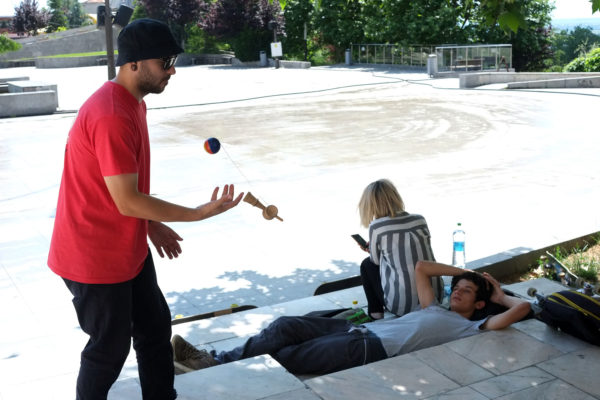
As far as freestyle goes, it ended up being the same group as the previous days’ trip to Craiova by the time it was cool enough to skate, but Slatina’s street skaters were a very different breed to their Craiovan counterparts; younger and more innocent, there was no hint of a “too cool” attitude amongst the group, and while there was still a noticeable amount of physical distance between the freestylers and the street riders due to the sheer size of the space, all in all, it was a very chill session. Families walked through, heading to the cultural centre or one of the bars, and no one seemed to mind about the noise and movement created by the many skaters in the plaza.
I would later ask Marius what the older folks thought of the growing skate community; unsurprisingly, the reaction is much the same as we get in other areas where skateboarding is more established. The big concern, as always, is the damage that street skateboarding does to the environment and the speed at which street skaters move through a space. Unlike other countries, however, there isn’t a big push for corralling everyone into skateparks; Slatina itself only has a small arrangement of a prefab quarterpipe and funbox at the other end of town, although Marius has been trying to get a modern concrete plaza built for quite a while. The local government are certainly keen (they’ve even paid for Marius to travel to international competitions to represent his country a couple of times), but there’s a lot of other projects which are higher up on the priority list for funding. It’s worth noting at this point that I was pleasantly surprised by Slatina; there were some absolutely stunning public spaces and parks, and there’s been a real move since the economic slump of the early 90s to “beautify” some of the old Communist buildings – to the point where they look considerably more aesthetically pleasing than their equivalents in London.
With regards to the actual skateboarding – freestyle is definitely developing quite well in Romania. This was the first opportunity I’ve had to have a casual session with the two Alexandrus, and it’s interesting to see them both progressing down such different paths, even if there is a common tendency towards 80s nostalgia for both of them. Lilea spent most of the session working on rolling double fingerflips, 540 variants and handstand shuvits; Stirbu preferring more complex and esoteric 50-50 tricks as a general rule. Both are learning fast; Lilea went on to win the amateur division in Paderborn a month later.
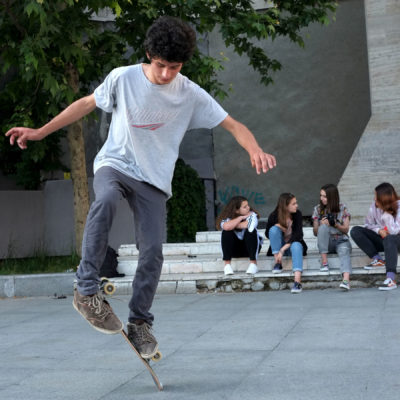
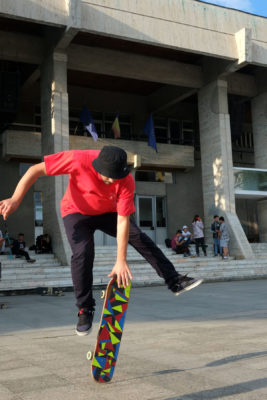
Marius, meanwhile, has finally found chance to take a step back from the arduous task of getting his business up and running and is putting in the time on the board again, and it shows. He ended up picking up fourth place – his best pro result – in Paderborn. If he keeps this up he could be a contender for podium places next year. Surrounded with this group, the young Daniel Popescu should have all the inspiration and guidance he needs. His enthusiasm really showed through – every time I was finished shooting a trick of one of the older guys, Daniel would come and pester me to shoot some photos of him. It was really great to see. Since I returned home, a few of the street skaters I met have been making the transition and getting involved in the local freestyle scene, too. There’s a real future here.
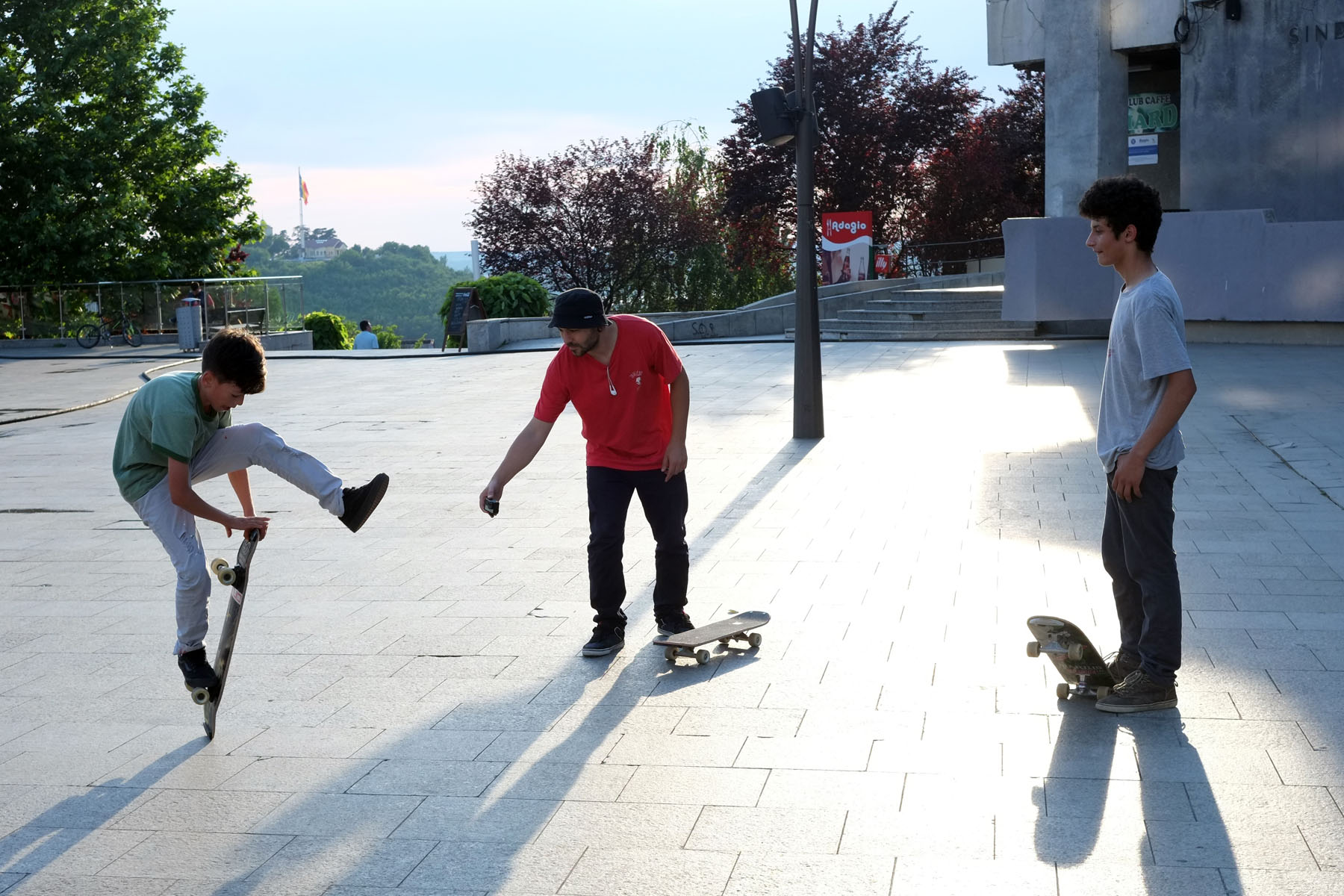
We ended the day at Marius’ place with Romanian wine and some traditional food, cooked by his friend (and now freestyler) Catalin. Another major surprise on this trip was how good Romanian food and drink is. The country is still very agrarian, with incredible vineyards and amazing fresh fruit and vegetables. If you get the chance to try some Romanian wine, give it a go!

I couldn’t come to Romania and not go to Bucharest; I think Bianca, Marius’ other half, may have murdered him if he didn’t take me to see the capital. Marius lived in the city for a while; all he ever told me about it is how much he hates it. Far too busy, too much traffic, expensive, etc. – all the standard complaints made about every major city worldwide.
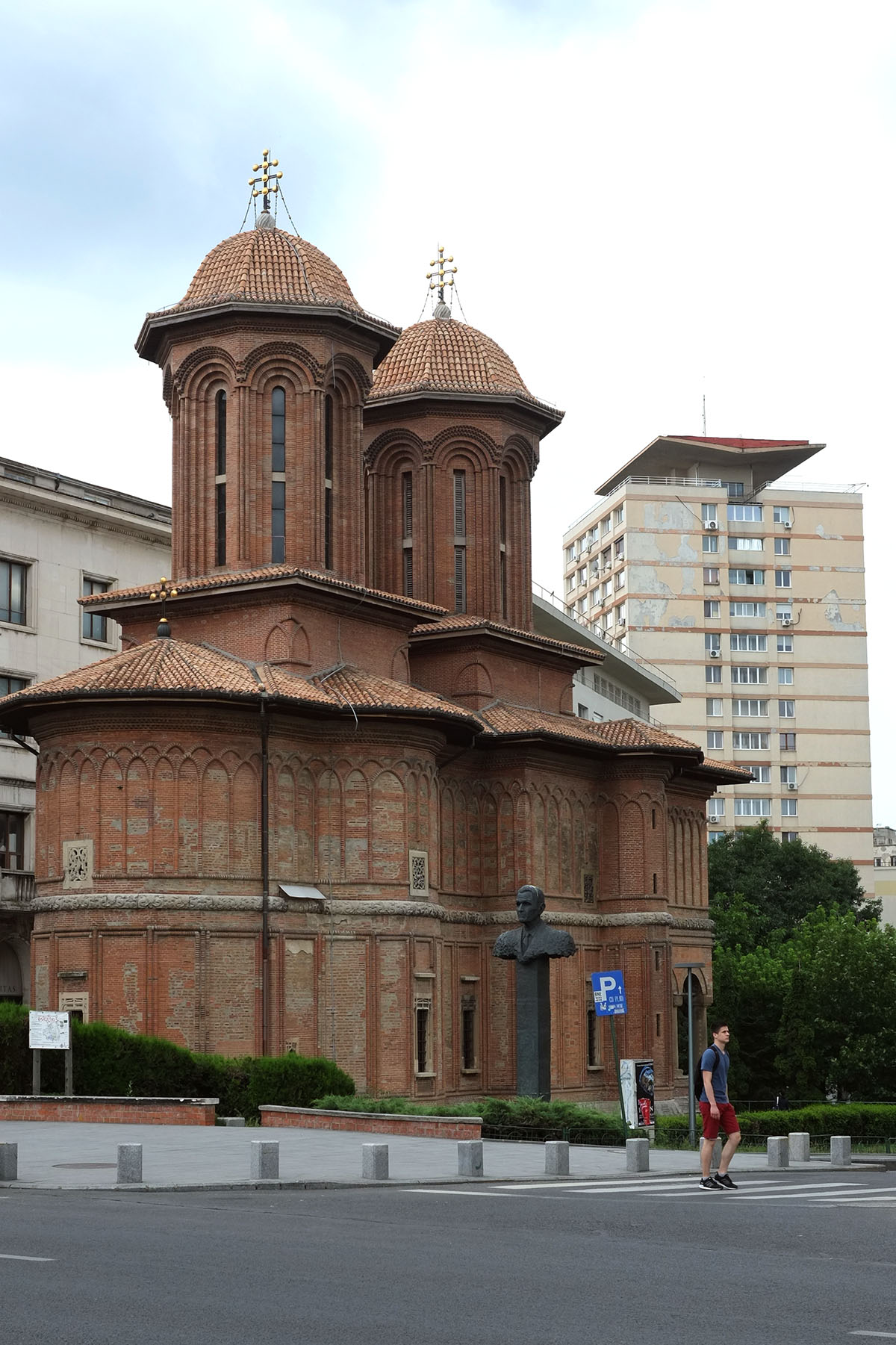
One of the constant themes running through my time in Romania was contrast. You have three definite time periods all sitting uncomfortably side-by-side; the traditional, the Communist, and the Capitalist. Bucharest exemplified that experience. One of the first things I saw as we walked from our parking space was a monument to the anti-communist revolutionaries, entitled “The Revival’s Memorial”. One minute later, there’s a beautiful old Orthodox church, apparently dating to the 1720s, with two crosses of Salem perched on the top of the twin bell towers – overshadowed by Ceaușescu-era apartment buildings. It’s such an unusual mishmash of architecture and history that, at points, it can seem quite overwhelming; there’s simply so much to take in, no matter where you look.
While we were strolling through the city, visiting bookstores, checking out old churches and feeding pigeons, someone randomly jumped off a bench, saying “Marius! Marius!” Marius went over and greeted the guy like they were old friends, and as I couldn’t understand a single word of the short conversation, I asked Marius for an explanation as we walked away. Turns out Marius didn’t know the guy at all – the guy knew him from Youtube. You wouldn’t have known it from how Marius interacted with him. Later he admitted to me that he finds it tiring sometimes, but it doesn’t show; it almost sickens me how goddamned nice he is sometimes.
Eventually we made it to our destination: a surprisingly large outdoor skatepark tucked away in a public park, with characteristic late 90s/early 2000s prefab jump ramps everywhere. I found the local skate crew effectively tucked away to one side with a couple of flatbars; the main park was swarming with scooter kids and the occasional BMXer. Every so often, one of the skaters would head off to try to skate some of the main park, and when they did, it became apparent that the skill level is quite high. Romania might not be a well-known skate Mecca, but the local scene certainly seems strong.
I took a couple of runs across the park, trying to relearn some of my old bank tricks on a very dodgy oversized wooden flatbank at one end (I swore it was flexing every time I landed on it). Eventually I gave up on trying to skate the haggard behemoth and spotted a section of the park which wasn’t part of any scooter lines, so co-opted it as a makeshift freestyle area. Before I knew it, there was three or four scooter kids who’s stopped riding and sat down on a ledge to watch. When they tried talking to me, I had to play the part of the ignorant Brit – “Sorry mate, I only speak English” – only to be met with absolutely perfect English from an eleven or twelve year old child in response. They came out with the usual response to freestyle (“what is this? I’ve never seen anyone do this sort of thing before! It’s amazing!”) before asking the inevitable question: “Why are you here? In Romania?” I was tempted to respond “because I had some time to kill and fuck me, Romania is a cheap place to visit”, but tried my best to explain that I was staying with a friend of mine who is also a professional freestyler. Thankfully, Marius appeared at that point (I think he’d wondered where I’d disappeared off to), and so I introduced him to the kids while the two Alexandrus attempted to wow the fledgling crowd. Once one of us mentioned Nose and Tail, they worked out who he was… but only from the kendamas he’d been selling for the last year or so.
You can’t win ’em all.


Although I had one more day in Romania, it seems fitting to end this piece with the end of my day in Bucharest. Stirbu left the group when we jumped onto the subway after the skate session, and Marius dropped Bianca off at her tram, leaving just Marius, Alexandru Lilea and myself for the two hour ride back to Slatina. As we headed back to the car, we stumbled upon a group of street skaters hanging out at a local spot – a very, very battered war memorial which has seen more than its fair share of street skating in the last two decades. One of the guys had his arm strapped up, and I got talking to him – his name was Razvan Popescu, and Marius would tell me later that he’s pretty damn good, with a whole bunch of sponsorships to his name. This post on his Instagram is actually him skating the memorial we met at.
One of the things we started talking about was the difficulty of being one of the first skaters in a region, how tough it is not having people there with you to learn from. I could empathise; starting out as a freestyler in England in 2001 was nigh-impossible, with learning new tricks like fumbling in the dark. Everything feels like reinventing the wheel. Razvan and other guys his age in Romania went through the same experience with skateboarding in general; they could see what was possible through print media and video, but pre-Youtube, they had no one to tell them how to flick their foot for a heelflip, how to keep your head up during a backside flip. It’s pretty amazing to me to see how far skaters like Razvan have come, and how such a young scene has flourished in the last twenty years, despite the economic difficulties they’ve faced. It says a lot about the tenacity of the Romanian people. Part of me hopes that, to a certain degree, they can stay under the radar; the last thing Romania needs is Barcelona-style skate tourism ruining the local skaters’ relationship with the government and non-skaters. However, while the skateboarding industry isn’t paying much attention to Romania right now, the Romanians – especially the freestylers – are getting a whole lot better and are starting to look out at the world around them.
It’s only a matter of time before the world starts looking back.

